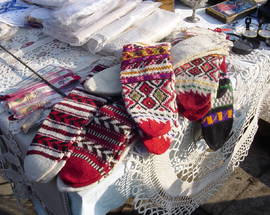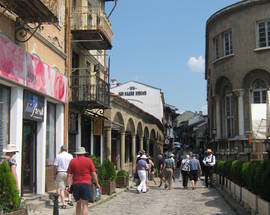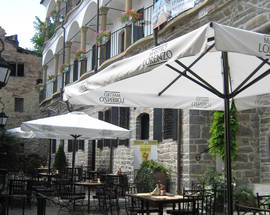The relatively well preserved mediaeval Tsarevets fortress is the most visited historical site in the country. There is much more to see in Veliko Tarnovo than Tsarevets, however, and those tourists who only swing by in their air-conditioned coaches to tick off this box are missing the laid-back atmosphere of this lovely town.
Be prepared to give your feet a good bashing and wear sensible shoes as you explore the cobbled alleys and marvel at the houses built into the rocks overhanging the river. Be forewarned that there are little, if no, facilities for the disabled.
The city has been inhabited since the 3rd millenium B.C., remains having been found on the now overgrown Trapezitsa hill. Thracian tribes lived on Tsarevets hill in the Bronze and Iron ages but the Romans preferred nearby Nicopolis ad Istrum with its hot springs. The town's golden age came with the declaration of independence from the Byzantine empire in 1185 by the local Boliar (an aristocratic title) brothers Ivan Assen and Peter in Veliko Tarnovo. They subsequently conducted a two-year battle with the empire to secure Bulgaria's freedom and in 1187 the Second Bulgarian Kingdom was born, with its capital Turnovgrad (Veliko Tarnovo), and the brothers became Tsars. They are referred to as the 'Assens', together with a third brother, Kaloyan, who took over after their deaths. The fourth 'Assen' is Ivan Assen II, the son of Ivan Assen, who ruled from 1218 to 1241 and brought the Kingdom to new heights, conquering neighbouring lands that gave it access not only to the Black Sea but also to the Aegean and Adriatic seas.
The city was built on three hills: Tsarevets, Trapezitsa and Sveta Gora. Tsarevets and Trapezitsa formed an 'innner city' surrounded by impenetrable walls, where the royal palace, residence of the Patriarch (head of the church) and many places of worship were located, as well as the grand mansions of the high-ranking aristocracy, while an 'outer city', also fortified, spread down to Assenova Mahala by the river where the craftsmen lived and the neighbourhood of foreign traders. Only the poorest people lived outside the walls. The Second Bulgarian Kingdom came to an end in 1393 when Turnovgrad fell to the Ottoman Turk troops after a three month seige and so began almost 500 years of cultural, spiritual and political stagnation until the National Revival movement began to awaken the Bulgarians' sense of national pride as the Ottoman Empire's strength waned. The liberation of Bulgaria in 1877 again placed Turnovo
The name Tarnovo (often written Turnovo) is believed to come from the Slavic word 'trun', meaning thorn, though other theories link it to the roman word for fortress. The word 'Veliko', meaning ‘great’, was officially only added in 1966.




